The Castle of
Marienburg - Malbork Castle
The
Castle of the Teutonic Order in Malbork (Polish: Zamek w Malborku; German: Ordensburg Marienburg)
is a 13th-century Teutonic castle and fortress located near the town of Malbork, Poland.
It is the largest castle in the world measured by land area and a UNESCO World Heritage Site.
It was originally constructed by the Teutonic Knights, a German Catholic
religious order of crusaders, in a form of an Ordensburg fortress. The Order named
it Marienburg in honour of Mary, mother of Jesus. In 1457, during the Thirteen Years’
War, it was sold by the Bohemian mercenaries to King Casimir IV of Poland in lieu of indemnities and it since served
as one of the several Polish royal residences and the seat of Polish offices and institutions, interrupted by several years
of Swedish occupation, and fulfilling this function until the First Partition of Poland in 1772. From then on the castle was
under German rule for over 170 years until 1945.
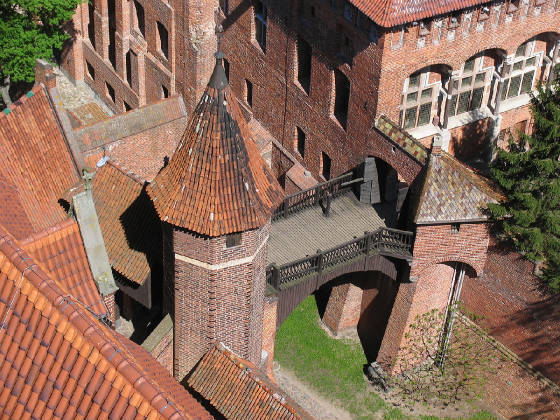
The castle is a classic example of a medieval fortress
and, on its completion in 1406, was the world's largest brick castle. UNESCO designated the "Castle of the Teutonic Order
in Malbork" and the Malbork Castle Museum a World Heritage Site in December 1997. It is one of two World Heritage Sites
in the region (north-central Poland), together with the "Medieval Town of Toruń", which was founded in 1231.
Malbork Castle is also one of Poland's official national Historic Monuments (Pomnik
historii), as designated on 16 September 1994. Its listing is maintained by the National
Heritage Board of Poland.
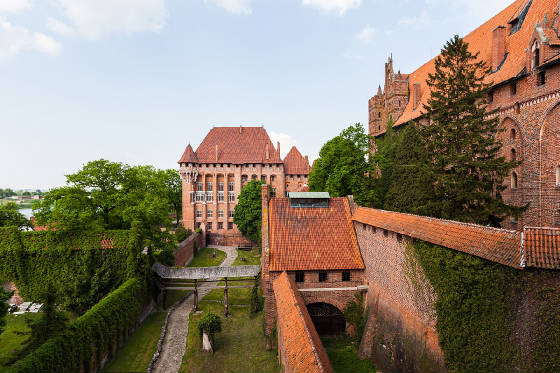
The castle was built by the Teutonic Order after
the conquest of Old Prussia. Its main purpose was to strengthen their own control of the area following the Order's 1274 suppression
of the Great Prussian Uprising of the Baltic tribes. No contemporary documents survive relating
to its construction, so instead the castle's phases have been worked out through the study of architecture and the Order's
administrative records and later histories. The work lasted until around 1300, under the auspices of Commander Heinrich
von Wilnowe.
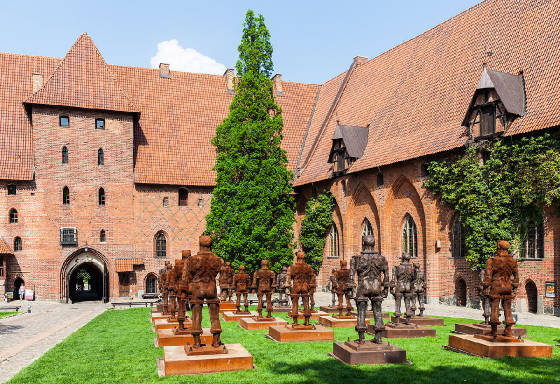
The castle is located on the southeastern bank of the river
Nogat. It was named Marienburg after Mary, patron saint of the religious Order. The Order had been created in Acre
(present-day Israel). When this last stronghold of the Crusades fell to Muslim Arabs, the Order moved its headquarters to
Venice before arriving in Prussia. Malbork became more and more important in the aftermath of the Teutonic Knights' conquest
of Gdańsk (Danzig) and Eastern Pomerania in 1308. The Order's administrative centre was moved to Marienburg from Elbing
(now Elbląg). The Grand Master of the Teutonic Knights, Siegfried von Feuchtwangen,
who arrived in Marienburg from Venice, undertook the next phase of the fortress' construction. In 1309, in the wake of the
papal persecution of the Knights Templar and the Teutonic takeover
of Danzig, Feuchtwangen relocated his headquarters to the Prussian part of the Order's monastic
state. He chose the site of Marienburg conveniently located on the Nogat in the Vistula Delta. As with most cities
of the time, the new centre was dependent on water for transportation.
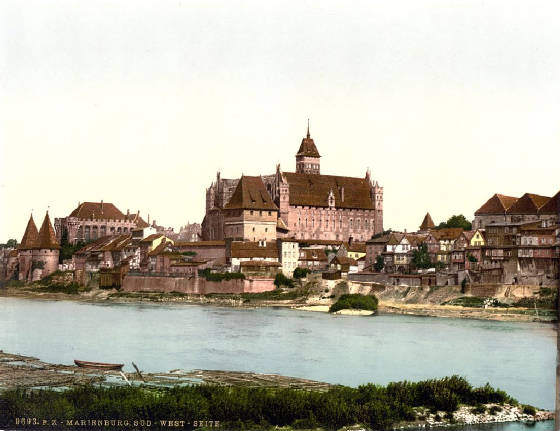
The castle was expanded several times to house the growing
number of Knights. Soon, it became the largest fortified Gothic building in Europe, on a nearly 21-hectare (52-acre)
site. The castle has several subdivisions and numerous layers of defensive walls. It consists of three separate castles
- the High, Middle and Lower Castles, separated by multiple dry moats and towers. The castle once housed approximately
3,000 "brothers in arms". The outermost castle walls enclose 21 ha (52 acres), four times the enclosed
area of Windsor Castle. The developed part of the property designated as a World Heritage Site is 18.038 ha (44.57 acres).
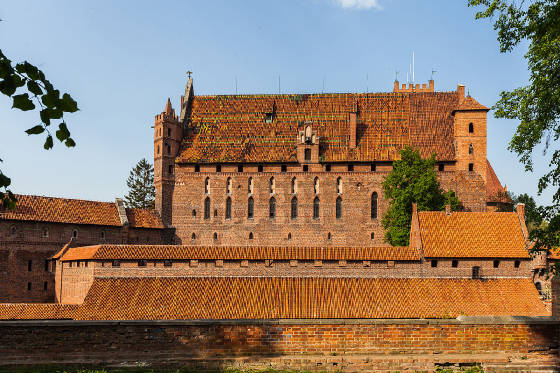
The favourable position of the castle on the river Nogat
allowed easy access by barges and trading ships arriving from the Vistula and the Baltic Sea. During their governance,
the Teutonic Knights collected river tolls from passing ships, as did other castles along the rivers. They controlled
a monopoly on the trade of amber. When the city became a member of the Hanseatic League, many Hanseatic meetings were held
there. In 1361 the future Grand Duke of Lithuania Kęstutis was briefly imprisoned in the castle. In 1365, Polish King
Casimir III the Great visited the castle. In the summer of 1410, the castle was besieged following the Order's defeat by
the armies of Władysław II Jagiełło and Vytautas
the Great (Witold) at the Battle of Grunwald. Heinrich von Plauen successfully led the defence in the Siege of Marienburg
(1410), during which the city outside was razed.
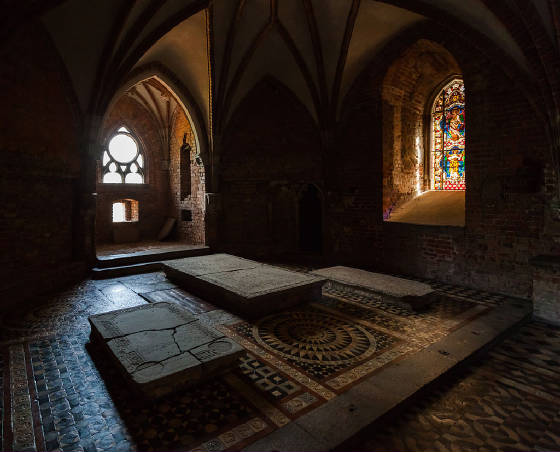
In 1456, during the Thirteen
Years' War, the Order – facing opposition from its cities for raising taxes to pay ransoms for expenses associated
with its wars against Kingdom of Poland – could no longer manage financially. Meanwhile, Polish General Stibor
de Poniec of Ostoja raised funds from Danzig for a new campaign against them. Learning that the Order's Bohemian
mercenaries had not been paid, Stibor convinced them to leave. He reimbursed them with money raised in Danzig. Following
the departure of the mercenaries, King Casimir IV Jagiellon entered the castle in triumph in 1457, and in May, granted
Danzig several privileges in gratitude for the town's assistance and involvement in the Thirteen
Years' War (1454–66) as well as for the funds collected for the mercenaries that left. The mayor of the town around the castle, Bartholomäus Blume, resisted the Polish forces
for three more years, but the Poles captured and sentenced him to death in 1460. A monument to Blume was erected
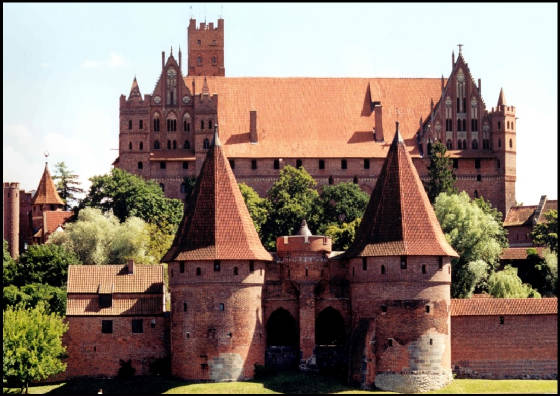
In 1466 both castle and town became part of the Polish
Malbork Voivodeship in the province of Royal Prussia. Since 1457 it served as one of the several Polish royal residences,
fulfilling this function for over 300 years (over twice as long as it was headquarters of the Teutonic Order) until
the Partitions of Poland in 1772. During this period the Tall Castle served as the castle's supply storehouse, while the
Great Refectory was a place for balls, feasts, and other royal events. Polish Kings often stayed in the castle, especially
when travelling to the nearby city of Gdańsk/Danzig. Local Polish officials resided in the castle. From 1568 the
castle housed the Polish Admiralty (Komisja Morska) and in 1584 one of the Polish Royal Mints was established here.
Also, the largest arsenal of the Polish–Lithuanian Commonwealth was located in the castle. By the decision of King
John II Casimir Vasa of 1652, Jesuits took care of the castle chapels of Mary and St. Anne. During the Thirty Years' War, in 1626 and 1629 Swedish forces occupied the castle.
They invaded and occupied it again from 1656 to 1660 during the Deluge. Then the castle was visited by Swedish kings Gustav
Adolf (in 1626) and Charles X Gustav (in 1656).
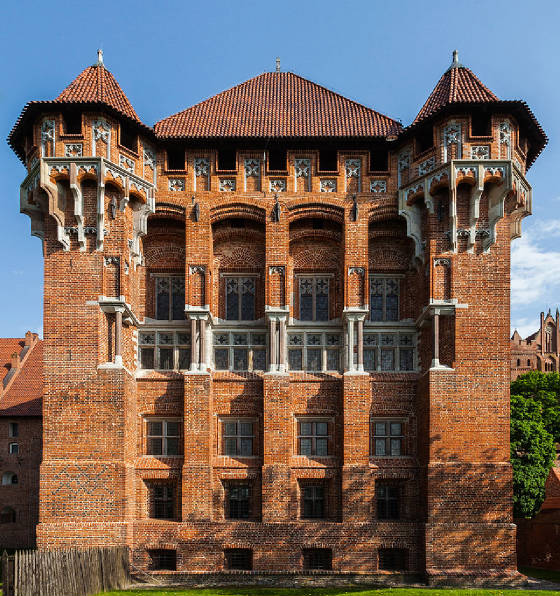
After Prussia and the Russian Empire made the First Partition
of Poland in 1772, the town was annexed by the Kingdom of Prussia and in 1773 it became part of the newly established province
of West Prussia. At that time, the officials used the rather neglected castle as a poorhouse and barracks for the Prussian
Army. The last Jesuits left the castle in 1780. In 1794 David Gilly, a Prussian architect and head of the Oberbaudepartement,
made a structural survey of the castle, to decide about its future use or demolition. Gilly's son, Friedrich Gilly, produced
several engravings of the castle and its architecture, which he exhibited in Berlin and had published by Friedrich Frick
from 1799 to 1803. These engravings led the Prussian public to "rediscover" the castle and the history of the
Teutonic Knights.Johann Dominicus Fiorillo published another edition of the engravings on 12 February 1803, also wanting to
encourage public interest. Max von Schenkendorf criticized the defacement of the castle. Throughout the Napoleonic period,
the army used the castle as a hospital and arsenal. Napoleon has visited the castle in 1807 and 1812. After the War of the
Sixth Coalition, the castle became a symbol of Prussian history and national consciousness. Initiated by Theodor von Schön,
Oberpräsident of West Prussia, in 1816, restoration of the castle was begun. In 1910 the Naval
Academy Mürwik in Flensburg was built.
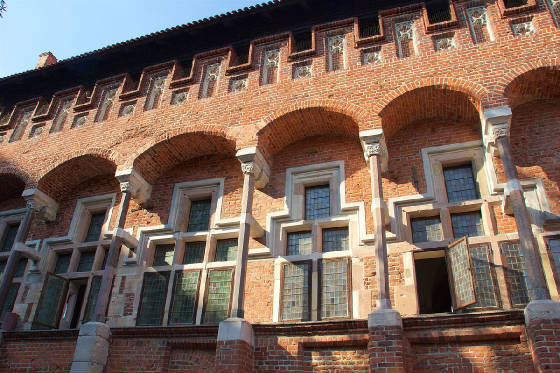
The Marienburg was a pattern for this new Red Castle.
The restoration of the Marienburg was undertaken in stages until World War II started. With the rise of Adolf Hitler to power
in the early 1930s, the Nazis used the castle as a destination for annual pilgrimages of
both the Hitler Youth and the League of German Girls. The Teutonic Castle at Marienburg served as a blueprint for the Order
Castles of the Third Reich built under Hitler's reign. In 1945 during World War II combat in the area, more than half the
castle was destroyed.
